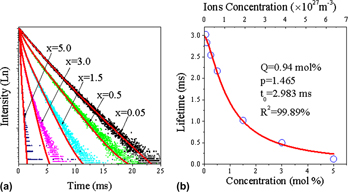Crossref Citations
This article has been cited by the following publications. This list is generated based on data provided by
Crossref.
Yang, JingWen
Guo, Hai
Wei, YunLe
Noh, Hyeon Mi
and
Jeong, Jung Hyun
2014.
Luminescence and energy transfer process in Cu^+,Sm^3+ co-doped sodium silicate glasses.
Optical Materials Express,
Vol. 4,
Issue. 2,
p.
315.
Kaur, Preet
Singh, Devinder
and
Singh, Tejbir
2016.
Optical, photoluminescence and physical properties of Sm3+ doped lead alumino phosphate glasses.
Journal of Non-Crystalline Solids,
Vol. 452,
Issue. ,
p.
87.
Thomas, V.
Sofin, R.G.S.
Allen, M.
Thomas, H.
Biju, P.R.
Jose, G.
and
Unnikrishnan, N.V.
2017.
Optical analysis of samarium doped sodium bismuth silicate glass.
Spectrochimica Acta Part A: Molecular and Biomolecular Spectroscopy,
Vol. 171,
Issue. ,
p.
144.
Zhang, Liaolin
Xia, Yu
Shen, Xiao
and
Wei, Wei
2018.
A significant enhancement emission of Sm3+–Ag+codoped silicate glasses under UV excitation.
Journal of Materials Research,
Vol. 33,
Issue. 16,
p.
2434.
Chen, Jing-Yi
Pan, He
Zhang, Liao-Lin
Guo, Hai-Tao
and
Liu, Chun-Xiao
2019.
Sm3+-doped bismuthate glasses and proton-implanted near-infrared waveguides.
International Journal of Modern Physics B,
Vol. 33,
Issue. 04,
p.
1950004.
Singh, Randev
Singh, Amrit
Singh, Devinder
and
Tyagi, Mintu
2019.
Studies of photon interaction and shielding parameters of lead alumino-borophosphate glass system.
Radiation Physics and Chemistry,
Vol. 161,
Issue. ,
p.
60.
Kaur, Preet
Singh, Devinder
and
Singh, Tejbir
2019.
Sm3+ and Gd3+ Co-doped lead phosphate glasses for γ-rays shielding and sensing.
Journal of Luminescence,
Vol. 209,
Issue. ,
p.
74.
Pascuta, Petru
Stefan, Razvan
Olar, Loredana Elena
Bolundut, Liviu Calin
and
Culea, Eugen
2020.
Effects of Copper Metallic Nanoparticles on Structural and Optical Properties of Antimony Phosphate Glasses Co-Doped with Samarium Ions.
Materials,
Vol. 13,
Issue. 21,
p.
5040.
Bolton, James
2021.
New NIR emission from Sm3+ in Yb3+-Sm3+ co-doped tellurite glass.
Journal of Luminescence,
Vol. 231,
Issue. ,
p.
117717.
Singh, Dalip
Singh, Surinder
Singh, Tejbir
and
Kaur, Preet
2021.
Samarium and gadolinium-co-doped lead borate glasses for luminescent applications.
Journal of Materials Science: Materials in Electronics,
Vol. 32,
Issue. 6,
p.
6900.
Meejitpaisan, Piyachat
Doddoji, Ramachari
Kim, Hong Joo
Jayasankar, Chalicheemalapalli K.
and
Kaewkhao, Jakrapong
2023.
Photoluminescence and X‐Ray‐Induced Luminescence Behavior of Sm2O3‐Doped Oxyfluoroborate Scintillating Glass for Radiation Detecting Material.
physica status solidi (a),
Vol. 220,
Issue. 10,





